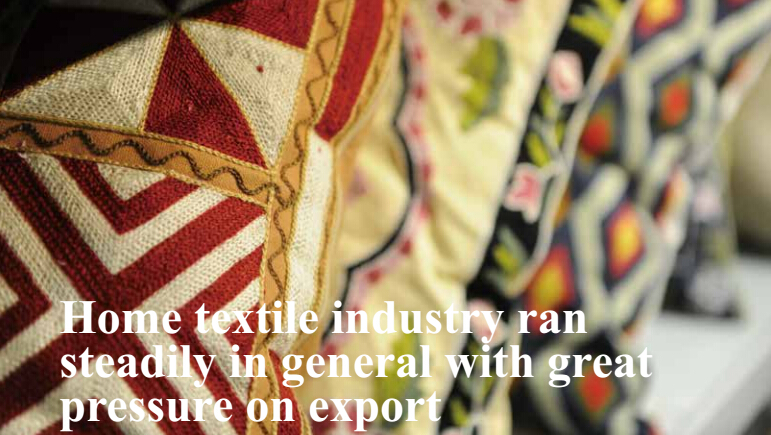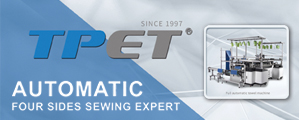Home textile industry ran steadily in general with great pressure on export
Mar 07, 2016 | by
Home textile industry ran steadily in general with great pressure on export
By Xu Yuanyuan

From the industrial operation statistics in 1-11 months, 2015, the home textile industry runs steadily in general, the main business income of the enterprises above the designated size leveled off with the same period of last year. The quality of industry and benefit, including the investment, increased steadily with the exception of export growth that was in a mire of further downslide, with the regional differentiation more obvious in some important markets.
The industrial scale leveled off with accelerating adjustment
Home textile industry runs steadily in general. According to the National Bureau of Statistics, the main business income of the 1,850 home textile enterprises above designated size realized 234.8 billion yuan from Jan. to Nov.2015 and leveled off with the same period of last year. The industry slipped gradually on condition that the national economy declined and the weak driving force inadequately worked on domestic market.
The employment showed a decline on year-on-year basis, but the industrial average per capita income improved thanks to speeding up the adjustment of home textile and improving the industrial production efficiency, as is in the same case of the 13 industrial clusters in home textile industry showing a fall 1.1% year on year in jobs creation and a rise 3.5% year on year in the average per capita income. It also argues well that the number of people in 209 enterprises tracked on statistical survey by China Home-textile Association decreased by 4.6% and the average per capita income is increased by 2.3%. Some enterprises reduced cost by putting robots onto the assembly line and improved the productive efficiency where the costs were much higher.
The data from the industrial cluster showed that the production was stable in general, while the sub-sector was different and showed a fluctuation to the effect that the bedding productions decreased sharply, the towels showed a decline compared with last year, and the upholstery saw a slight growth year on year.
The benefit ran steadily with a growth
It is important to emphasize that the quality of home textile economy was still promoted although the industrial growth was declining at the same time, which will be prominent in 2016.
Generally speaking, thehome textile industry is better in terms of economic performance. The whole profit of the 1,850 enterprises above the designated size was 13.28 billion yuan in 1-11 months, 2015, up 3.7% year on year, faster than the main business income, with the profit margin running at 5.7% and 0.2 percentage point higher than the same period of last year. The percentage of the three expenses (referring to the costs in sales, overheads and financing) was 6% and decreased by 0.1 percentage point compared with last year. 208 enterprises, or rather, 11.2 percent out of these 1,850 businesses were running in the red, with 0.52 billion yuan losses, down 6.7% year on year.
According to the performance indicators, the home textile enterprises paid much attention to the benefit other than the market share, crediting this achievement to the strengthened efficiency of management by reducing the three expenses and to the relatively low price of cotton that allowed for the cost fall in the raw material procurement.
Investment ran smoothly
The National Bureau of Statistics also showed that the investment in the home textile industry grew up by 18.4% year on year, covering some sectoral growths as seen in the curtain enterprises that accomplished the actual investment and behaved the best, up by 26.4%, and in the bedding enterprises that ranked the second place, up by 21.6%, and in the towel enterprises that stepped up slowly,but on a firm increase by 12.6%. There are 1,172 new industrial projects with steady growth, up by 35.3% year on year.
Export registered a negative growth with drops in volume and price
According to the General Administration of Customs, the latest data showed that the total home textile export was USD 36.61 billion in 1-11 months,2015, down by 4.9% year on year, with the volume that declined by 2.4% and the price that fell by 2.5%. The main reason for export weakness is the falling demand in international market as well as the exchange rate.
In 1-11 months, 2015, our export to the three traditional markets of America, European Union (EU) and Japan was USD 18.31 billion, down by 1.1% year on year. Specifically, our export to America maintained a high growth, up by 7.1% year on year, owning to the recovery of American economy and the depreciation of RMB against USD. However, the export to EU and Japan showed a continuous decline, down by 6% and 12.6% respectively, which had a certain relationship with the appreciation of USD against EU and yen. Without regard to the exchange rate, calculated by EU and yen, our export of home textile products to EU was 5.2 billion Euros, up by 14.4% year on year, to Japan was 384.9 billion yens, up by 2.7% year on year.
The economic growth of the emerging economies affected by external environment and internal economic structural adjustment was slowing down, which was hard to reverse in a very short time. With this setting, our export to the emerging markets continued to drop and the foreign trade pressure will continue to grind. In 1-11 months, 2015, our accumulative export to other countries, in addition to the three traditional markets, was USD 18.3 billion, down 8.4% year on year. To be more exact, the exports to the ASEAN countries, which are our third-largest export destinations, increased by 2.2% year on year, maintaining a certain growth on the basis of higher growth rate recorded in the same period of 2014, in contrast to a declined rate of 4.5% to the Middle East. Referring to Russia, affected by its weak domestic economy, the export of home textiles was USD 650 million and sharply decreased by 61.6% with the largest declining share. It is worth mentioning that the export to South Asia countries (India, Pakistan, and Bangladesh) saw a rapid growth rate, which was inseparable with the accelerating economic development in India.
From the point of export product category, the home textile (beddings, towels and upholstery) export showed a decline in 1-11 months, 2015 compared with the same period in previous year. Specifically, the export of beddings, towels and upholstery were down by 6.9%, 15.3%, and 3.9% respectively year on year.
There are several reasons for the negative growth in export. Firstly, the anemic external demand is the main reason and the chronic downturn of the global economy suppressed the growth impetus of the home textile export. Referring to the developed markets, American economy is on a good wicket in contrast to the slowing situation in Euro-zone countries and Japan, while the market risk of the emerging economies was intensified. Secondly, exchange rate. Some countries speculated on depreciation and took it as method to stimulate growth, leading to the passive appreciation of RMB, which severely affected China’s export products’ competitiveness in the international market. Thirdly, the export of home textile in China accounted for 40% of the world home textile, which was very big. Therefore, this negative growth is nothing but a normal phenomenon accorded with the laws of economy under the circumstances of the feeble recovery of international economy and the sluggish external demand.
Sales in domestic market ran steadily at growth speed
The growth speed of domestic sales decreased continuously, but still kept growing positively in business at the time when the home textile industry was in the transformation. According to the National Bureau of Statistics, the domestic market value of 1,850 enterprises above the designated size reached 181.57 billion yuan, up 1.2% year on year in 1-11 months 2015, in contrast to 13 industrial clusters that realized 5.9% more impressively. China Home Textile Association (CHTA) has tracked 209 key home textile enterprises with 0.1% decline, on a par with the same period of last year.
It is worth mentioning that the specialized market of the home textile (referring to the home textile-specific wholesale markets, distribution centers etc.) was highly valued with a steady growth on transaction in contrast to the slowing growth of the domestic market.
Industry forecast in 2016
In terms of export, the global economic performance is not satisfactory. Although the American economy is recovering, the growth is slow. The European and Japanese economy is at a standstill, and the appreciation of euro and yen is much bigger than RMB. The emerging economies either in strong or weak growth, are intermingled together with very different demand dimensions as we can see that India’s economy has gradually entered into the rapid growth period, though most countries and regions are at the decline stage. For example, Brazil, Russia etc. are in the recession. What’s more, the currency in some emerging countries has depreciated sharply or even some monetary systems are on the brink of collapse, which has added many uncertainties to the future home textile export. Against this background, China still faces big export challenge in 2016 and it is very difficult to ease this pressure in the short time.
At home, the improvement of the domestic market is still the main power in pulling the home textile industry. China has been carrying forward the new urbanization policy to promote the rural family members who have the ability to live in stable employment to settle down in cities, which was a stimulus for home textile market. The actual growth of the per capita disposable income in the whole year of 2015 increased by 7.4%, which showed that the consumption ability was right hereat home. The sales space of commercial house increased by 6.5% and would have a positive impact on home textile industry. In addition, the home textile industry should adapt the environmental change in the new normal, attaching less importance to the total quantity, speeding up the adjustment; strengthening the management level and improving the quality and efficiency of the enterprise level under the guidance of de-capacity and de-inventory policies.








